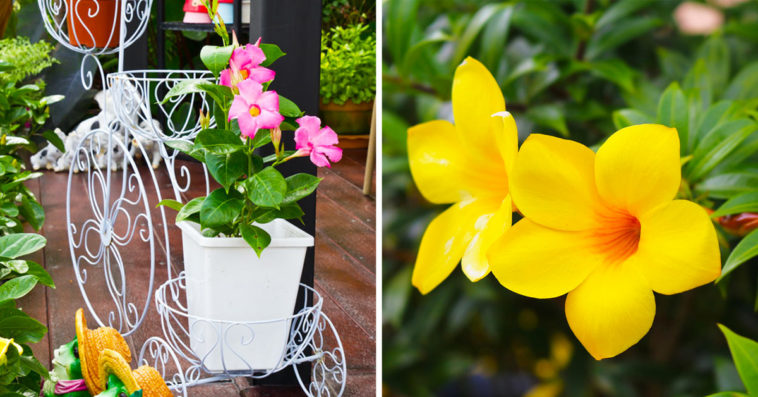Allamanda is a plant with yellow flowers and shiny green leaves, which is so beautiful that it looks fake. It is a true masterpiece of nature, which adorns walls, pergolas and paths and lasts a long time. It is a great choice if you want to enjoy the beauty of nature with a heat loving climbing plant like the Allamanda which is native to the Americas.
Allamanda is a climbing plant that beautifies walls, small pathways, and rockeries with its bright yellow trumpet-shaped flowers and small shiny light green leaves. This plant can also be grown in a pot, but should be stored in places where the temperature is always around 25 ° because it does not like the cold. Allamanda is evergreen and the most common variety is Allamanda cathartica, which has yellow flowers but can also have pink or purple flowers.
This plant looks fake because it is so aesthetically perfect and maintains that beauty for a long time during the year. It should be watered during the growing season and watered sparingly in the fall and during the cold months. Allamanda is the right choice if you want to give eye-catching and long-lasting beauty.
Allamanda: species and characteristics
The Allamanda family also includes species that have flowers other than the usual yellow flowers. The most common species has yellow five-pointed flowers, but there are also varieties with purple, white, pink and other shades. Its leaves are bright light green, pointed and shiny. This plant should be placed in a sunny position because it likes heat and hates cold: it should never live in a place with a temperature below 10 degrees.
The leaves of the Allamanda are lance-shaped, similar to those of the oleander, and the plant’s stem is about a meter and a half tall. The Allamanda flower is a golden yellow, bell-shaped flower. The seeds of this plant fall to the ground in the wind and make it even more beautiful.
Allamanda plant © stock.adobe
Cultivation and care of the Allamanda
Allamanda is a plant that prefers acidic soil, rich in organic matter but well drained. It blooms in spring and autumn. In summer and spring, it needs constant watering, while in autumn, only one watering per week is sufficient.
This plant should be fertilized every 20 days with liquid fertilizers which are dissolved in the irrigation water. Allamanda can be grown on balconies, although it is mostly used to decorate walls, pergolas and pergolas. Allamanda can be attacked by red spider mites and mealybugs and can be treated with an ornamental insecticide to address these issues.
A beautiful purple bell-shaped flower for this Allamanda who manages to decorate gracefully and simply.
© stock.adobe
© stock.adobe
Unparalleled delicacy, the Allamanda can bring a breath of beauty not only when it is climbing but also when grown in pots and placed in a corner of the garden or terrace.
© stock.adobe
To see also:
This beautiful plant with its purple flowers is a delight on the balcony in summer and winter.
SHARE ON:
Follow Ehomedecor.net on



